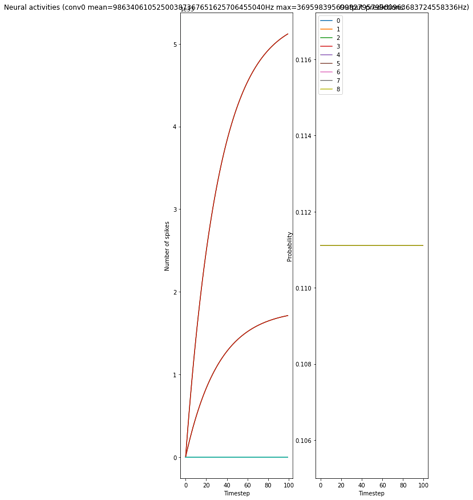Thank you so much for the reference, It helped.
But I followed this code Nengo/nengo_test1.ipynb at main · alekshex/Nengo · GitHub but i dont understand why the loss is really huse.
from sklearn.metrics import mean_squared_error
from math import sqrt
def RunNetwork(
model,
inputTest,
outputTest,
activation,
params_file="./nengo-model-relu-1",
n_steps=30,
scale_firing_rates=1,
synapse=None,
n_test=15000,
):
# convert the keras model to a nengo network
nengo_converter = nengo_dl.Converter(
model,
swap_activations={tf.nn.relu: activation},
scale_firing_rates=scale_firing_rates,
synapse=synapse,
)
inputLayer = model.get_layer('input_5')
hiddenLayer1 = model.get_layer('dense_13')
outputLayer = model.get_layer('dense_14')
# get input/output objects
nengo_input = nengo_converter.inputs[inputLayer]
nengo_output = nengo_converter.outputs[outputLayer]
# add a probe to the first layer to record activity.
# we'll only record from a subset of neurons, to save memory.
sample_neurons = np.linspace(
0,
np.prod(hiddenLayer1.output_shape[1:]),
100,
endpoint=False,
dtype=np.int32,
)
with nengo_converter.net:
probe_l1 = nengo.Probe(nengo_converter.layers[hiddenLayer1][sample_neurons])
# repeat inputs for some number of timesteps
testInputData = np.tile(inputTest[:n_test], (1, n_steps, 1))
# set some options to speed up simulation
with nengo_converter.net:
nengo_dl.configure_settings(stateful=False)
# build network, load in trained weights, run inference on test
with nengo_dl.Simulator(
nengo_converter.net, minibatch_size=100, progress_bar=False
) as nengo_sim:
nengo_sim.load_params(params_file)
data = nengo_sim.predict({nengo_input: testInputData})
# compute accuracy on test data, using output of network on
# last timestep
predictions = np.argmax(data[nengo_output][:, -1], axis=-1)
#accuracy = (predictions == outputTest[:n_test,0]).mean()
#print("Test accuracy: %.2f%%" % (100 * accuracy))
n = 66
t = outputTest[:n_test]
t1 = t[:-n, :]
print(t1.shape)
#newarr = data[nengo_output].reshape(2200,30*9)
#print(newarr.shape)
#idx_IN_columns = [0,1,2,3,4,5,6,7,8]
# extractedData = newarr[:,idx_IN_columns]
#print(extractedData.shape)
#mse = mean_squared_error(t1, extractedData)
mse = mean_squared_error(t1, data[nengo_output][:n_test, -1]) #normalized comparison
print('\nMSE Nengo run net prediction of {} samples: {}\n\n'.format(n_test, mse))
# plot the results
for ii in range(3):
plt.figure(figsize=(12, 15))
plt.subplot(1, 3, 1)
scaled_data = data[probe_l1][ii] * scale_firing_rates
if isinstance(activation, nengo.SpikingRectifiedLinear):
scaled_data *= 0.001
rates = np.sum(scaled_data, axis=0) / (n_steps * nengo_sim.dt)
plt.ylabel("Number of spikes")
else:
rates = scaled_data
plt.ylabel("Firing rates (Hz)")
plt.xlabel("Timestep")
plt.title(
"Neural activities (conv0 mean=%dHz max=%dHz)" % (rates.mean(), rates.max())
)
plt.plot(scaled_data)
plt.subplot(1, 3, 2)
plt.title("Output predictions")
plt.plot(tf.nn.softmax(data[nengo_output][ii]))
plt.legend([str(j) for j in range(10)], loc="upper left")
plt.xlabel("Timestep")
plt.ylabel("Probability")
plt.tight_layout()
Model: "model_4"
_________________________________________________________________
Layer (type) Output Shape Param #
=================================================================
input_5 (InputLayer) [(None, 8)] 0
_________________________________________________________________
dense_12 (Dense) (None, 50) 450
_________________________________________________________________
dense_13 (Dense) (None, 50) 2550
_________________________________________________________________
dense_14 (Dense) (None, 9) 459
=================================================================
Total params: 3,459
Trainable params: 3,459
Non-trainable params: 0
_________________________________________________________________
Build finished in 0:00:00
Optimization finished in 0:00:00
Construction finished in 0:00:00
Epoch 1/50
60/60 [==============================] - 2s 10ms/step - loss: 123382645707592641153086676315144192.0000 - probe_loss: 123382645707592641153086676315144192.0000 - val_loss: 2436953723512029184.0000 - val_probe_loss: 2436953723512029184.0000
Epoch 2/50
60/60 [==============================] - ETA: 0s - loss: 3139064446324760576.0000 - probe_loss: 3139064446324760576.00 - 0s 5ms/step - loss: 3144638822838040576.0000 - probe_loss: 3144638822838040576.0000 - val_loss: 2436953723512029184.0000 - val_probe_loss: 2436953723512029184.0000
RunNetwork(
NNa,
inputTestNgo,
outputTest,
activation=nengo.SpikingRectifiedLinear(),
params_file="./nengo-model-relu-1",
n_steps=100,
synapse=0.032,
scale_firing_rates=1500,
#n_test=100
)

